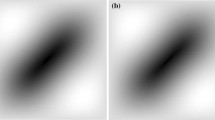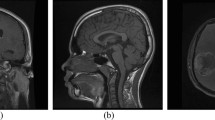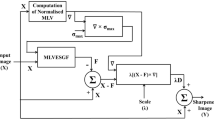Abstract
Unsharp Masking (UM) is a popular technique widely used for sharpening medical imagery. However, UM has two operational parameters which have crucial influence on its performance. They are amount (λ) and threshold (α). Improper selection of the threshold and amount will cause noise amplification and overshoot artefact, respectively. A fully adaptive UM with data driven operational parameters, for sharpening Magnetic Resonance (MR) images is proposed in this paper. The proposed sharpening scheme is compared with the homomorphic filter in terms of sharpness of the output image, width of salient edges, feature preservation, saturation and edge quality degradation due to noise. The proposed scheme of UM is found to be superior to homomorphic filter in terms of edge strength and feature preservation and it is free from overshoot artefacts. Modified configuration of UM, proposed in this paper can be used for improving the edge quality of MR images. It can be incorporated as a plug-in in software tools used for the automated analysis of MRI.











Similar content being viewed by others
References
Alasadi AHH, Al-Saedi AKH (2017) A method for micro-calcifications detection in breast mammograms. J Med Syst:41–68
Anoop BN, Joseph J, Williams J, Jayaraman JS, Sebastian AM, Sihota P (2018) A prospective case study of high boost, high frequency emphasis and two-way diffusion filters on MR images of glioblastoma multiforme. Australas Phys Eng Sci Med 41(2):415–427
Brettle D, Carmichael F (2011) The impact of digital image processing artefacts mimicking pathological features associated with restorations. Br Dent J 211:167–170
Cui J, Liu Y, Xu Y, Zhao H, Zha H (2013) Tracking generic human motion via fusion of low- and high-dimensional approaches. IEEE Trans Syst Man Cybern Syst 43(4):996–1002
Datta E, Papinutto N, Schlaeger R, Zhu A, Carballido-Gamio J, Henry RG (2017) Grey matter segmentation of the spinal cord with active contours in MR images. NeuroImage 147:788–799
Deng G (2011) A generalized unsharp masking algorithm. IEEE Trans Image Process 20(5):1249–1261
Deng H, Deng W, Sun X, Ye C, Zhou X (2016) Adaptive intuitionistic fuzzy enhancement of brain tumor MR images, Scientific Reports 6, Article number: 35760, Nature
Fan CN, Zhang FY (2011) Homomorphic filtering based illumination normalization method for face recognition. Pattern Recogn Lett 32(10):1468–1479
Feichtenhofer C, Fassold H, Schallauer P (2013) A perceptual image sharpness metric based on local edge gradient analysis 20(4):379–382
Fernández SA, Ciak TP, Ferrero GVS (2015) Spatially variant noise estimation in MRI: a homomorphic approach. Med Image Anal 20(1):184–197
Geng Y, Liang RZ, Li W, Wang J, Liang G, Xu C, Wang JY (2016) Learning convolutional neural network to maximize Pos@ Top performance measure, arXiv preprint arXiv:1609.08417
Grigoryan AM, Dougherty ER, Agaian SS (2016) Optimal wiener and homomorphic filtration: review. Signal Process 121:111–138
Guan J, Zhang W, Gu J, Ren H (2015) No-reference blur assessment based on edge modelling. J Vis Commun Image Represent 29:1–7
Hajiaghayi M, Groves EM, Jafarkhani H, Kheradvar A (2017) A 3-D active contour method for automated segmentation of the left ventricle from magnetic resonance images. IEEE Trans Biomed Eng 64(1):134–144
Hari VS, Jagathy Raj VP, Gopikakumari R (2013) Unsharp masking using quadratic filter for the enhancement of fingerprints in noisy background. Pattern Recogn 46(12):3198–3207
İlk HG, Jane O, İlk Ö (2011) The effect of Laplacian filter in adaptive unsharp masking for infrared image enhancement. Infrared Phys Technol 54(5):427–438
Ilunga-Mbuyamba E, Avina-Cervantes JG, Garcia-Perez A, de Jesus Romero-Troncoso R, Aguirre-Ramos H, Cruz-Aceves I, Chalopin C (2017) Localized active contour model with background intensity compensation applied on automatic MR brain tumor segmentation. Neurocomputing 220:84–97
Joseph J, Periyasamy R (2018) A fully customized enhancement scheme for controlling brightness error and contrast in magnetic resonance images. Biomed Signal Process Control 39:271–283
Joseph J., Periyasamy R (2018) An image driven bilateral filter with adaptive range and spatial parameters for denoising magnetic resonance images. Electrical & Computer Engineering. https://doi.org/10.1016/j.compeleceng.2018.02.033 (In press)
Joseph J, Jayaraman S, Periyasamy R, Simi VR (2017) An objective method to identify optimum clip-limit and histogram specification of contrast limited adaptive histogram equalization for MR images. Biocybernetics and Biomedical Engineering, Available online 20 January 2017
Khadidos A, Sanchez V, Li CT (2017) Weighted level set evolution based on local edge features for medical image segmentation. IEEE Trans Image Process 26(4):1979–1991
Krasula L, Le Callet P, Fliegel K, Klíma M (2017) Quality assessment of sharpened images: challenges, methodology, and objective metrics. IEEE Trans Image Process 26(3):1496–1508
Li Q, Zhou X, Gu A, Li Z, Liang RZ (2016) Nuclear norm regularized convolutional Max Pos@Top machine. Neural Comput Applic
Liang RZ, Shi L, Wang H, Meng J, Wang JJY, Sun Q, Gu Y (2016) Optimizing top precision performance measure of content based image retrieval by learning similarity function. Proc. 23rd International Conference on Pattern Recognition (ICPR)
Liang RZ, Xie W, Li W, Wang H, Wang JJY, Taylor L (2016) A novel transfer learning method based on common space mapping and weighted domain matching, proc. IEEE 28th International Conference on Tools with Artificial Intelligence (ICTAI)
Lin SCF, Wong CY, Jiang G, Rahman MA, Ren TR, Kwok N, Shi H, Yu Y-H, Wu T (2016) Intensity and edge based adaptive unsharp masking filter for color image enhancement. Optik 127(1):407–414
Liu Y, Nie L, Han L, Zhang L, Rosenblum DS (2015) Action2Activity: recognizing complex activities from sensor data, IJCAI
Liu Y, Zhang L, Nie L, Yan Y, Rosenblum DS (2016) Proc. Thirtieth AAAI Conference on Artificial Intelligence, p 201–207
Liu Y, Zheng Y, Liang Y, Liu S, Rosenblum DS (2016) Urban Water Quality Prediction Based on Multi-task Multi-view Learning, Proc. Twenty-Fifth International Joint Conference on Artificial Intelligence (IJCAI-16), pp.2576–2582
Liu Y, Nie L, Liu L, Rosenblum DS (2016) From action to activity: sensor-based activity recognition. Neurocomputing 181:108–115
Panetta K, Zhou Y, Agaian S, Jia H (2011) Nonlinear unsharp masking for mammogram enhancement. IEEE Trans Inf Technol Biomed 15(6):918–928
Polesel A, Ramponi G, Mathews VJ (2000) Image enhancement via adaptive unsharp masking. IEEE Trans Image Process 9(3):505–510
Trentacoste M, Mantiuk R, Heidrich W, Dufrot F (2012) Unsharp masking, countershading and halos: enhancements or artefacts? Comput Graph Forum 31(2):555–564
Unsharp masking, Documentation, https://in.mathworks.com/help/images/ref/imsharpen.html
Wang Z, Bovik AC, Sheikh HR, Simoncelli EP (2004) Image quality assessment: from error visibility to structural similarity. IEEE Trans Image Process 13:600–612
Xiao L, Li C, Wu Z, Wang T (2016) An enhancement method for X-ray image via fuzzy noise removal and homomorphic filtering. Neurocomputing 195:56–64
Zhao Y, Guo S, Luo M, Liu Y, Bilello M, Li C (2017) An energy minimization method for MS lesion segmentation from T1-w and FLAIR images. Magn Reson Imaging 39:1–6
Author information
Authors and Affiliations
Corresponding author
Additional information
Publisher’s Note
Springer Nature remains neutral with regard to jurisdictional claims in published maps and institutional affiliations.
Rights and permissions
About this article
Cite this article
Joseph, J., Anoop, B.N. & Williams, J. A modified unsharp masking with adaptive threshold and objectively defined amount based on saturation constraints. Multimed Tools Appl 78, 11073–11089 (2019). https://doi.org/10.1007/s11042-018-6682-1
Received:
Revised:
Accepted:
Published:
Issue Date:
DOI: https://doi.org/10.1007/s11042-018-6682-1




